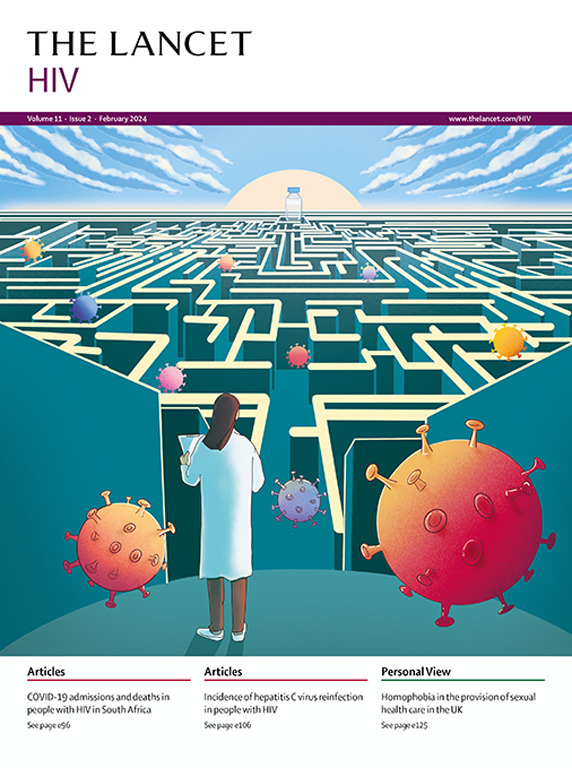在乌干达和赞比亚,护理人员协助儿童进行口腔黏膜检测的HIV自我检测的可接受性、可行性和有效性:一项前瞻性干预性研究。
IF 13
1区 医学
Q1 IMMUNOLOGY
引用次数: 0
摘要
背景:在2019冠状病毒病大流行期间,美国总统艾滋病紧急救援计划支持护理人员辅助艾滋病毒自我检测(cg -HIV),以解决儿童艾滋病毒诊断方面的差距。我们的目的是调查护理人员对cg - hiv的接受程度、结果反馈、可接受性和潜在的社会危害。方法本前瞻性、干预性研究在乌干达的32家卫生机构和赞比亚的15家卫生机构进行。年龄在18岁及以上的照顾者(加上乌干达15-17岁的未成年人)感染艾滋病毒,目前正在接受艾滋病毒护理,被认为是指标病例,对亲密伴侣暴力筛查没有积极反应,以及有一个或多个年龄在18个月至14岁的儿童感染艾滋病毒状况未知,有资格参加。为符合条件的护理人员提供口腔hiv检测试剂盒来筛查他们的孩子,并根据护理人员和儿童特征描述主要结果。在给药后,使用标准化问卷对护理人员进行调查,以记录他们的看法、不良事件和社会危害。主要结局是接受艾滋病毒检测和返回筛查试验结果的数量和比例、反应性结果、带有确认性艾滋病毒检测的反应性筛查、带有阳性结果的确认性检测,以及与治疗相关的确认艾滋病毒阳性儿童。该研究已在ClinicalTrials.gov注册,注册号为NCT04774666和NCT04754386,目前已完成。从2021年2月1日至10月31日,对12998名感兴趣的护理人员进行了资格筛选,其中4023人符合条件。3903人(97.0%)接受艾滋病毒检测试剂盒对其子女进行艾滋病毒筛查(赞比亚1609人[41.2%],乌干达2294人[58.8%])。在3903名照顾者中,女性3094名(79.3%),男性809名(20.7%)。共纳入7601例儿童,其中女性3779例(49.7%),男性3822例(50.3%)。乌干达4866例检测结果中有4766例(97.9%)返回,赞比亚2735例中有2647例(96.8%)返回。7413例儿童中有119例(1.6%)hiv检测结果阳性,需要进行确认性检测。在116名接受确认性检测的儿童中,43名被确认为艾滋病毒阳性(乌干达的艾滋病毒感染率为0.7% [n=32],赞比亚为0.4% [n=11]), 100%接受了抗逆转录病毒治疗。不良事件罕见(2720例中有11例[0.4%])且轻微,无社会危害或暴力事件报告。接受调查的护理人员表示hiv - st试剂盒易于使用(2718人中有2637人[97.0%]),他们会再次使用(2674人中有2650人[99.1%]),并会向其他家长推荐(2674人中有2615人[97.8%])。我们的研究结果表明,口服cg -HIV - st是可接受的、可行的和安全的,没有社会危害的报告,并且有可能扩大儿童获得艾滋病毒检测的机会,同时减少卫生机构的服务提供负担。美国总统艾滋病救济紧急计划和威康信托基金。本文章由计算机程序翻译,如有差异,请以英文原文为准。
Acceptability, feasibility, and effectiveness of caregiver-assisted HIV self-testing among children using an oral mucosal test in Uganda and Zambia: a prospective interventional study.
BACKGROUND
During the COVID-19 pandemic, the US President's Emergency Plan for AIDS Relief supported oral caregiver-assisted HIV self-testing (CG-HIVST) to address the gap in HIV diagnosis of children. We aimed to investigate caregiver uptake, results return, acceptability, and potential social harms of CG-HIVST.
METHODS
This prospective, interventional, study was done at 32 health facilities in Uganda and 15 health facilities in Zambia. Caregivers aged 18 years and older (plus emancipated minors aged 15-17 years in Uganda) living with HIV who were currently accessing HIV care and considered index cases, with no positive responses to an intimate partner violence screen, and with one or more children aged 18 months to 14 years with unknown HIV status were eligible to participate. Eligible caregivers were offered oral HIVST kits to screen their children and primary outcomes were described by caregiver and child characteristics. Following HIVST kit administration, caregivers were surveyed using a standardised questionnaire to document their perceptions, adverse events, and social harm. Primary outcomes were the uptake of HIVST and the number and proportion of returned screening test results, reactive results, reactive screens with confirmatory HIV testing, confirmatory testing with a positive result, and children who were confirmed HIV-positive who were linked to treatment. This study was registered with ClinicalTrials.gov, NCT04774666 and NCT04754386, and is completed.
FINDINGS
From Feb 1 to Oct 31, 2021, 12 998 interested caregivers were screened for eligibility, 4023 of whom were eligible. 3903 (97·0%) accepted HIVST kits to screen their child for HIV (1609 [41·2%] in Zambia and 2294 [58·8%] in Uganda). Among caregivers, 3094 (79·3%) of 3903 were female, and 809 (20·7%) were male. 7601 children were enrolled (3779 [49·7%] were female and 3822 [50·3%] were male). 4766 (97·9%) of 4866 test results were returned in Uganda and 2647 (96·8%) of 2735 in Zambia. 119 (1·6%) of 7413 children had reactive HIVST results, requiring confirmatory testing. Of 116 children with confirmatory testing, 43 were confirmed HIV-positive (HIV prevalence 0·7% [n=32] in Uganda and 0·4% [n=11] in Zambia) and 100% were linked to antiretroviral therapy. Adverse events were rare (11 [0·4%] of 2720) and minor, and there were no reports of social harm or violence. Caregivers surveyed reported the HIVST kit was easy to use (2637 [97·0%] of 2718), they would use it again (2650 [99·1%] of 2674), and they would recommend it to other parents (2615 [97·8%] of 2674).
INTERPRETATION
Our findings suggest that oral CG-HIVST is acceptable, feasible, and safe, with no reports of social harm, and has the potential to expand access to HIV testing for children while reducing the service delivery burden on health facilities.
FUNDING
US President's Emergency Plan for AIDS Relief and Wellcome Trust.
求助全文
通过发布文献求助,成功后即可免费获取论文全文。
去求助
来源期刊

Lancet Hiv
IMMUNOLOGYINFECTIOUS DISEASES&-INFECTIOUS DISEASES
CiteScore
19.90
自引率
4.30%
发文量
368
期刊介绍:
The Lancet HIV is an internationally trusted source of clinical, public health, and global health knowledge with an Impact Factor of 16.1. It is dedicated to publishing original research, evidence-based reviews, and insightful features that advocate for change in or illuminates HIV clinical practice. The journal aims to provide a holistic view of the pandemic, covering clinical, epidemiological, and operational disciplines. It publishes content on innovative treatments and the biological research behind them, novel methods of service delivery, and new approaches to confronting HIV/AIDS worldwide. The Lancet HIV publishes various types of content including articles, reviews, comments, correspondences, and viewpoints. It also publishes series that aim to shape and drive positive change in clinical practice and health policy in areas of need in HIV. The journal is indexed by several abstracting and indexing services, including Crossref, Embase, Essential Science Indicators, MEDLINE, PubMed, SCIE and Scopus.
 求助内容:
求助内容: 应助结果提醒方式:
应助结果提醒方式:


